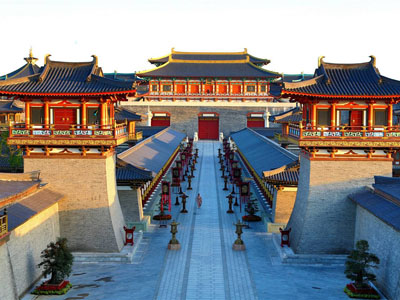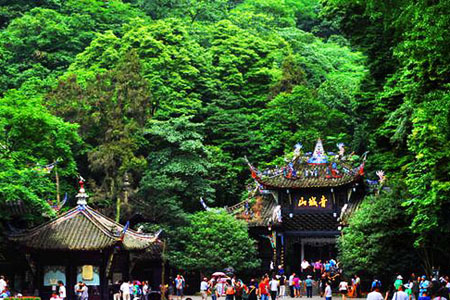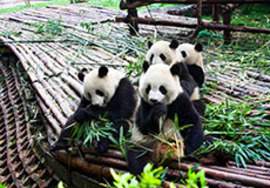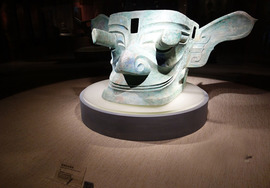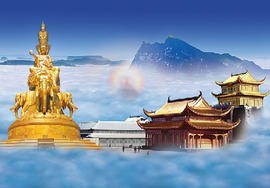Amdo Tibetan area is a lovely place in North Eastern Tibet. It has vast pastures, great potentiality in agricultural , and boundless water, mineral and wild life resources. It is also noted for its numerous snow mountains and the origin of Yangtze River, Yellow River and Lantsang River. There are large and small lakes scattering through out the regain.
In this land, you can enjoy the Kunun Mountain , Animaqing Mountain, salt lakes, Jiuzhaigou National Park , Roergai Grassland, etc. And also there are many famous scenic sports of humanity, such as Tare lamasery, Labrang Monastery, Danba Tower style Castles, etc. It also melted 33 ethnic groups, such as Tibetan, hui, Salar, Morgolian and tu.
Animaqin snow-mountain
Located in the Guoluk Tibetan Autonomous prefecture, it extends about 6282m above sea level. It is interspersed with lofty peaks and deeper canyons. This mountain range is known worldwide for its snow-capped pinnacles. The Animaqing mountain is a one of 21 holy mountains in whole Tibetan protecting Tibetan thousands years.
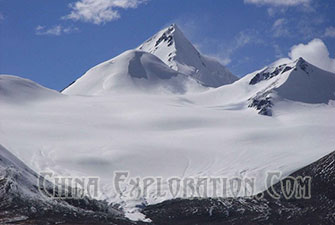
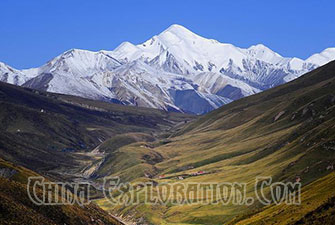
The source of Yellow River and Yangtze River
There are two famous rivers in Asia, one is the Yellow River and another one is Yangtze River , but the source of two rivers is in south part of Amdo. That is a very fascinating place, huge mountains, wide nature forest and grassland, kinds of wild lives, simple and honest local people, if you will been this land you can’t forgot it forever. The Yellow river of Amdo section, gentle, pretty and clear like an unmarried beauty, the tiny streams of the upper reach and star lake consisted with countless pools can hardly mark you associate with the limpid river water of the upper reach with that of the lower part which is turbid and swift. Walking by the riverbank of the up reach, you are expected to find out the natural charming of this internal river and its natural beauty, which is never artificial.
Labrang monastery
Labrang monastery is located in the Xiahe county of Gansu province. The monastery covers an area of more then 860,000 square meters, and the whole architectural compile occupies 400,000sq. The Labrang monastery was first built in 1709, just in the reign of Qing dynasty. After more then 200 years constant addition and restoration, Labrang monastery has formed into the present huge monastery complex with six colleges, numerous halls of Buddha, palaces for living Buddha, monks’ living quarters, sutra printing office, and it turned to be one of the most famous Buddhist centers in Tibet.
Wolong Natural Reserve is situated in the transitional zone between the Sichuan basin and Tibetan plateau, 140 kms northwest of Chengdu , and covers an area of 2000 square kilometer. In 1980 the Giant Panda Research and Protection Center was set up by the Chinese Government in cooperation with the World Wild Fund of Nature (WWF). At the same year the Wolong Natural Reserve was accepted by UNESCO as member of MAB natural reserve network.
Wolong is known as the "Hometown of Giant Panda" because of its rich recourses of Giant Pandas. Except the giant panda, various ecology environments also provide a habitation for many rare animal and plants. Some 103 mammals, 281 birds, 21 reptiles, 1700 insects and 4000 plant species are found in the reserve. It was reputed as “the Gene bank of nature species" and "natural animals and plants field". In stead of those, rich animal and specimen displaying house with big scale, growing modern glacier and historical remains of ancient glacier. There is conservation and research center for the giant panda and giant panda breeding station. Since Wolong Natural Reserve is far away from hubbub, wild life, the various plantation, primeval forests, snowy mountains will make you embrace the whole nature, cleanse pollution, forget yourself and posses an extremely wonderful world.
Located in Jiuzhaigou county in Sichuan province. In the south of Mt Mingshan, Jiuzhaigou National Nature Reserve lies in the 40 Km long valley of running North-South ward. The highest peak in it is 4764 meter with relative height of 2400 meters. The climate here is belong to the transitional zone of North Asia Tropical and temperate zone. The vertical dispersion of plants is very obvious here with rich recourse of plants and animals. The rare species of Giant Pandas, bluesheep, golden monkey, eared pheasant could be found here.
The most important of all, the natural view are very special in it. Hundreds of beautiful snow mountain lakes, many of grand waterfalls, dense virgin forest, alive precious animals and snow peaks surrounding all built up the beautiful and magic nature reserve. In 1992 it was accepted by the UNESCO as “ the World Culture and Nature Heritage Protection List ”.
Qinghai means green lake in Chinese and Qinghai Lake is the largest inland saltwater lake in China. Lying in the northeast of Qinghai Province, in the joint border of Gangcha, Haiyan and Gonghe County, approximately 150km (193 miles) from Xining at 3,200 meters (10,500ft) above sea level, the lake stretches endlessly into the horizon. It has an area of 4,952sq km and is more than 360km (220 miles) in circumference. It was approved and established by Qinghai Province Government in 1975,and it was promoted to national reserve in 1997. Its main protection targets are plateau marshy biogeocenose and rare Aves.
Danba lies along the eastern border of the Ganzi Tibet prefecture which lies in western Sichuan . The county is not far from Ya'an in the southeast, Kangding in the south and Daofu in the west. The county varies greatly in altitude, from peaks that are as high as 5,820 meters to river valleys as low as 1,700 meters.
The Big Jinchuan and Small Jinchuan Rivers meet here, marking the beginning of the Dadu River. The county's landscape is vertically changing, from the high-altitude snow-capped mountains, to glaciers and the low altitude grasslands and valleys. The main population here is composed of ethnic Tibetans.
The girls from Danba are famed to be the prettiest in the region, giving the valley a second nickname, " Beauty Valley." Beautiful local women clothed in their magnificent traditional dresses are a photographic treat for tourists and serious photographers alike. And their unique tower style castles are most fantastic in Tibetan area.
Related Tours
